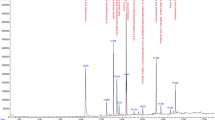Abstract
Cascabela thevetia (L.) Lippold (Apocynaceae) is an ornamental as well as poisonous plant which has antibacterial, antimicrobial, anti-inflammatory properties. The present study investigated the attenuating effects of the methanol extract of Cascabela thevetia fruits (MECT) on developmental toxicity and behavioral safety in zebrafish embryos. Healthy zebrafish eggs were selected by microscopic screening to study developmental toxicity and behavioral safety starting from 24 h post fertilization (hpf) up to 72 hpf. The zebrafish embryos were exposed in vivo to different concentrations (50, 100 and 200 μg/mL) of MECT. Developmental and morphological abnormalities pertaining to heart, notochord, head, eyes and pigments were recorded in the MECT treated embryos. Increase in heart rate, defective notochord, edema in the head, improperly placed eyes, and absence of pigments were observed with the increasing dose of MECT. The LC50 of the extract was determined based on observations from 1 hpf to 72 hpf and the value is 1000 mg/mL. Inconsistency in the above parameters with change in the dose of MECT corroborates to its toxic potential.




Similar content being viewed by others
References
Ambang Z, Ngoh JP, et al. (2010) Effect of Thevetia peruviana seeds extract on in vitro growth of four strains of Phytophthora megakarya. Plant Omics 3:70–76
Brand M, Granato M, et al (2002) Keeping and raising zebrafish. In: Zebrafish: a practical approach. Oxford University Press, UK, 7–37
Carlsson G, Patring J, et al. (2011) Developmental toxicity of albendazole and its three main metabolites in zebrafish embryos. Reprod Toxicol 32:129–137
Fleischer M (2007) Testing costs and testing capacity according to the REACH requirements – results of a survey of independent and corporate GLP laboratories in the EU and Switzerland. J Bus Chem 4:96–114
Genschow E, Spielmann H, et al. (2004) Validation of the embryonic stem cell test in the international ECVAM validation study on three in vitro embryotoxicity tests, alternatives to laboratory animals. ATLA 32:209–244
Haldar S, Karmakar I, et al. (2015) Antitumor potential of Thevetia peruviana on Ehrlich's ascites carcinoma-bearing mice. J Environ Pathol Toxicol Oncol 34:105–113
Harborne JB (1998) Phytochemical methods. Springer Private Limited, India
Hill A, Howard CV, et al. (2003) Neurodevelopmental defects in zebrafish (Danio rerio) at environmentally relevant dioxin (TCDD) concentrations. Toxicol Sci 76:392–399
Kammann U, Vobach M, et al. (2009) Acute toxicity of 353-nonylphenol and its metabolites for zebrafish embryos. Environ Sci Pollut Res 16:227–231
Kareru PG, Keriko, et al. (2010) Anti-termite and antimicrobial properties of paint made from Thevetia peruviana (Pers.) Schum. oil extract. Afr J Pharma Pharmacol 4:87–89
Kumar RHS, Makari HK, et al. (2007) In vitro antimicrobial activity of ethanol extract of Thevetia peruviana. Electron J Environ Agric Food Chem 6:2318–2322
Kumar RBS, Puratchikodi A, et al. (2011) Pre clinical studies of Streblus asper Lour. in terms of behavioral safety and toxicity. Orient Pharm Exp Med 11:243–249
Kumar RBS, Kar B, et al. (2013) Study on developmental toxicity and behavioral safety of Streblus asper Lour. bark on zebrafish embryos. Indian J Nat Prod Resour 4:255–259
Peters AK, Steemans M, et al. (2008) Evaluation of the embryotoxic potency of compounds in a newly revised high throughput embryonic stem cell test. Toxicol Sci 105:342–350
Rovida C, Hartung T (2009) Re-evaluation of animal numbers and costs for in vivo tests to accomplish REACH legislation requirements for chemicals – a report by the transatlantic think tank for toxicology. Altex 26:187–208
Saint-Amant L, Drapeau P (1998) Time course of the development of motor behaviors in the zebrafish embryo. J Neurobiol 37:622–632
Sanne AB, Hermsen TEP, et al. (2012) Concentration-response analysis of differential gene expression in the zebrafish embryo toxicity test following flusilazole exposure. Toxicol Sci 127:303–312
Seiler A, Visan A, et al. (2009) The use of embryonic stem cells for developmental toxicity testing. Reprod Toxicol 28:141–142
Selderslaghs IW, Van RAR, et al. (2009) Development of a screening assay to identify teratogenic and embryotoxic chemicals using the zebrafish embryo. Reprod Toxicol 28:308–320
Singh A, Kumar S (2005) Molluscicidal evaluation of three common plants from India. Fitoterpia 76:747–751
Tewtrakul S, Nakamura N, et al. (2002) Flavanone and flavonol glycosides from the leaves of Thevetia peruviana and their HIV-1 reverse transcriptase and HIV-1 integrase inhibitory activity. Chem Pharm Bull 50:630–635
Tiedeken JA, Ramsdell JS (2005) Developmental toxicity of domotic acid in zebrafish. Neurotoxicol Teratol 27:711–717
Westerfield M (1993) The zebrafish book: a guide for the laboratory use of zebrafish (Brachydanio rerio). University of Oregon Press, Eugene
Yang L, Ho NY, et al. (2009) Zebrafish embryos as models for embryotoxic and teratological effects of chemicals. Reprod Toxicol 28:245–253
Acknowledgments
The authors are thankful to the authority of Jadavpur University, Department of Pharmaceutical Technology, Kolkata, DST-SERB and UGC (201213-RGNF-2012-13-SC-WES-28590), New Delhi; India is gratefully acknowledged for providing research facilities and financial support.
Author information
Authors and Affiliations
Corresponding author
Ethics declarations
Ethical Statement
Ethical approval was not required because a zebra fish embryo does not fall within the definition of laboratory animal.
Conflict of Interest
The authors have no conflicts of interest. The authors alone are responsible for the content and writing of this article.
Rights and permissions
About this article
Cite this article
Haldar, S., Karmakar, I., Chakraborty, M. et al. Preclinical assessment of Cascabela thevetia fruits on developmental toxicity and behavioral safety in zebrafish embryos. Orient Pharm Exp Med 15, 371–377 (2015). https://doi.org/10.1007/s13596-015-0207-5
Received:
Accepted:
Published:
Issue Date:
DOI: https://doi.org/10.1007/s13596-015-0207-5




